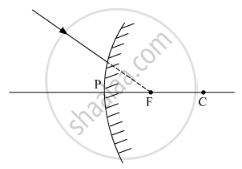Advertisements
Advertisements
प्रश्न
Whatever be the position of the object, the image formed by a mirror is virtual, erect and smaller than the object. The mirror then must be:
(a) plane
(b) concave
(c) convex
(d) either concave or convex
उत्तर
convex
It should be a convex mirror. This is because when an object is in front of a convex mirror, irrespective of its distance, a virtual, erect and diminished image of the object is obtained.
संबंधित प्रश्न
What happens to the image when the object is moved away from the mirror gradually?
A boy is standing in front of and close to a special mirror. He finds the image of his head bigger than normal, the middle part of his body of the same size, and his legs smaller than normal. The special mirror is made up of three types of mirrors in the following order from top downwards:
(a) Convex, Plane, Concave
(b) Plane, Convex, Concave
(c) Concave, Plane, Convex
(d) Convex, Concave, Plane
Draw ray diagrams to represent the nature, position and relative size of the image formed by a convex lens for the object placed:
at 2F1,
The magnification produced by a spherical mirror and a spherical lens is + 0.8.
(a) The mirror and lens are both convex
(b) The mirror and lens are both concave
(c) The mirror is concave but the lens is convex
(d) The mirror is convex but the lens is concave
The angle formed between the normal and the refracted ray is known as the angle of incidence.
Write true or false
The focal length of a convex mirror is equal to its radius of curvature.
A .............. mirror is obtained on silvering the outer surface of a part of a hollow glass sphere.
A ray of light passing through centre of curvature of a spherical mirror, after reflection

The image formed by these mirrors is ______ than the object.
